All products featured are independently chosen by us. However, SoundGuys may receive a commission on orders placed through its retail links. See our ethics statement.
A guide to hearing aids
May 18, 2023
Hearing loss can happen at any age. It’s considered a silent killer because it can lead to social withdrawal and it’s associated with mental decline. Hearing aids can restore some of your hearing and let you fully enjoy life, but it can be daunting to figure out which one is right for you.
Don’t worry, we’re here to help you navigate the world of hearing aids.
Editor’s note: This article was updated on May 18, 2023, to update formatting and the section on OTC hearing aids.
How does a hearing aid work?
To improve your hearing, hearing aids amplify certain sounds. This requires a few different parts:
- The microphone receives sound from your environment. Good hearing aids feature two microphones, an omnidirectional and a directional one.
- The amplifier enhances the sound.
- The receiver is actually a speaker that passes the amplified sound into your ear.
- The processor contains custom programs and data to optimize the sound for your hearing. The latest hearing aids have two processors.
- A battery powers the hearing aid. You can choose between replaceable or rechargeable batteries.
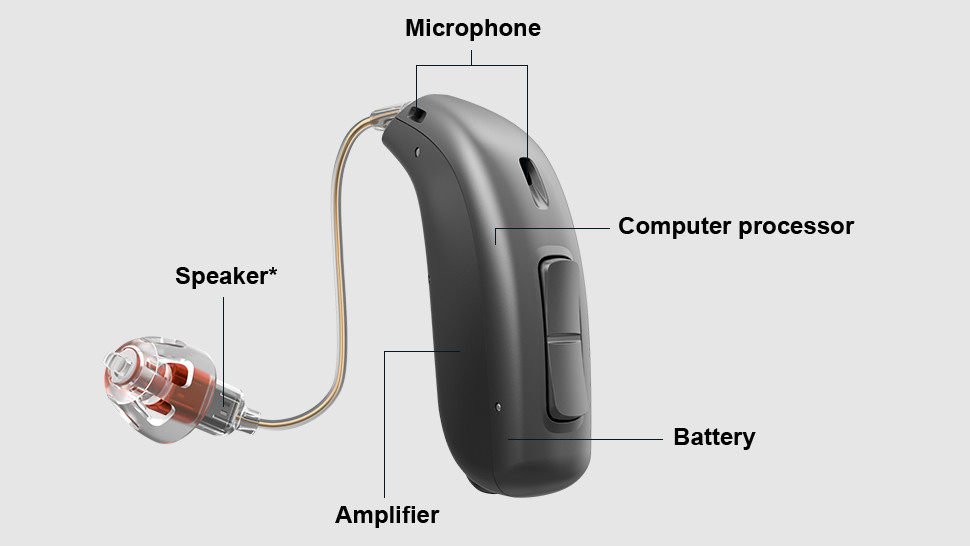
While older analog hearing aids boost all sounds equally, modern ones convert sound into a digital signal—allowing for advanced processing. Not only is the amplification stage customized to your hearing, digital hearing aids can also filter out loud background noises, and selectively amplify desired sounds like speech or music. What’s more: artificial intelligence enables state-of-the-art hearing aids to automatically adapt to your environment, though most let you manually switch to custom settings, too.
What types of hearing aids are there?
Hearing aids come in many different shapes and sizes.
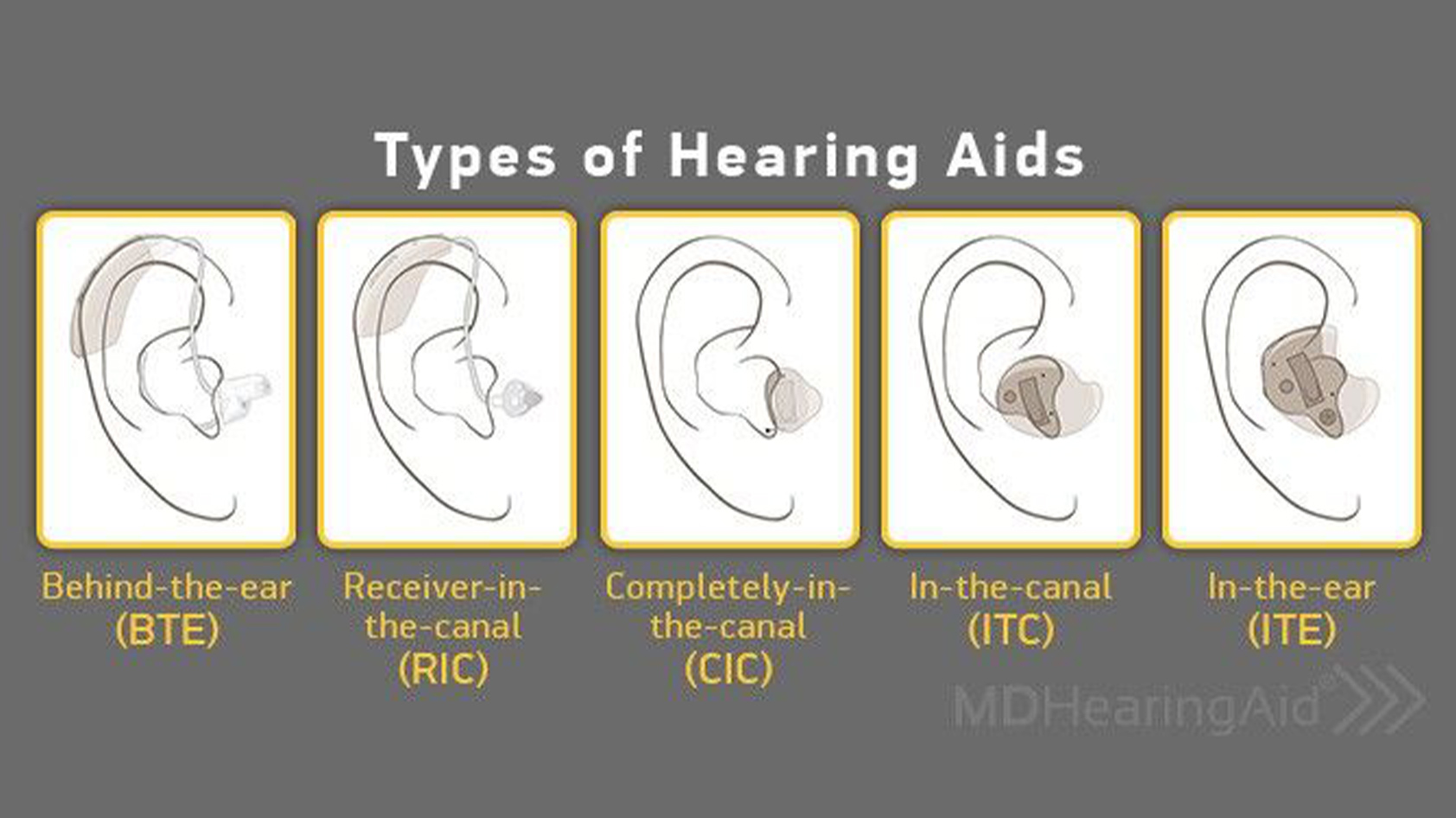
The style that’s best for you depends on the severity of your hearing loss, but also on your personal preferences. If you have only mild hearing loss, a model that doesn’t plug up your ear should be preferable. If you’re wearing glasses, you might want to avoid hearing aids that sit behind the ear. Keep in mind that smaller ear pieces require more dexterity for handling and maintenance.
Below is an overview of the most common types of hearing aids and their pros and cons.
Completely-in-the-canal
Completely-in-the-canal (CIC) or invisible-in-the-canal (IIC) are the smallest hearing aids on the market. They sit deep in the ear canal, making them nearly invisible. Only a small plastic handle that lets you insert and remove the hearing aid will peak out.
Due to their tiny size, they have a limited battery life and don’t pack as many features. This makes them best suited for people with mild to moderate hearing loss.
| Pros | Cons |
|---|---|
Almost invisible | Requires physical molding |
Tight custom fit | Blocked ear might feel uncomfortable and sound unnatural |
Outer ear funnels sounds | No controls on the aids |
Better directional hearing | Limited features |
Use headphones, telephones, or other headgear as usual | Low battery life |
Remote or app controlled | Difficult to handle |
Requires frequent maintenance | |
No rechargeable options |
In-the-canal
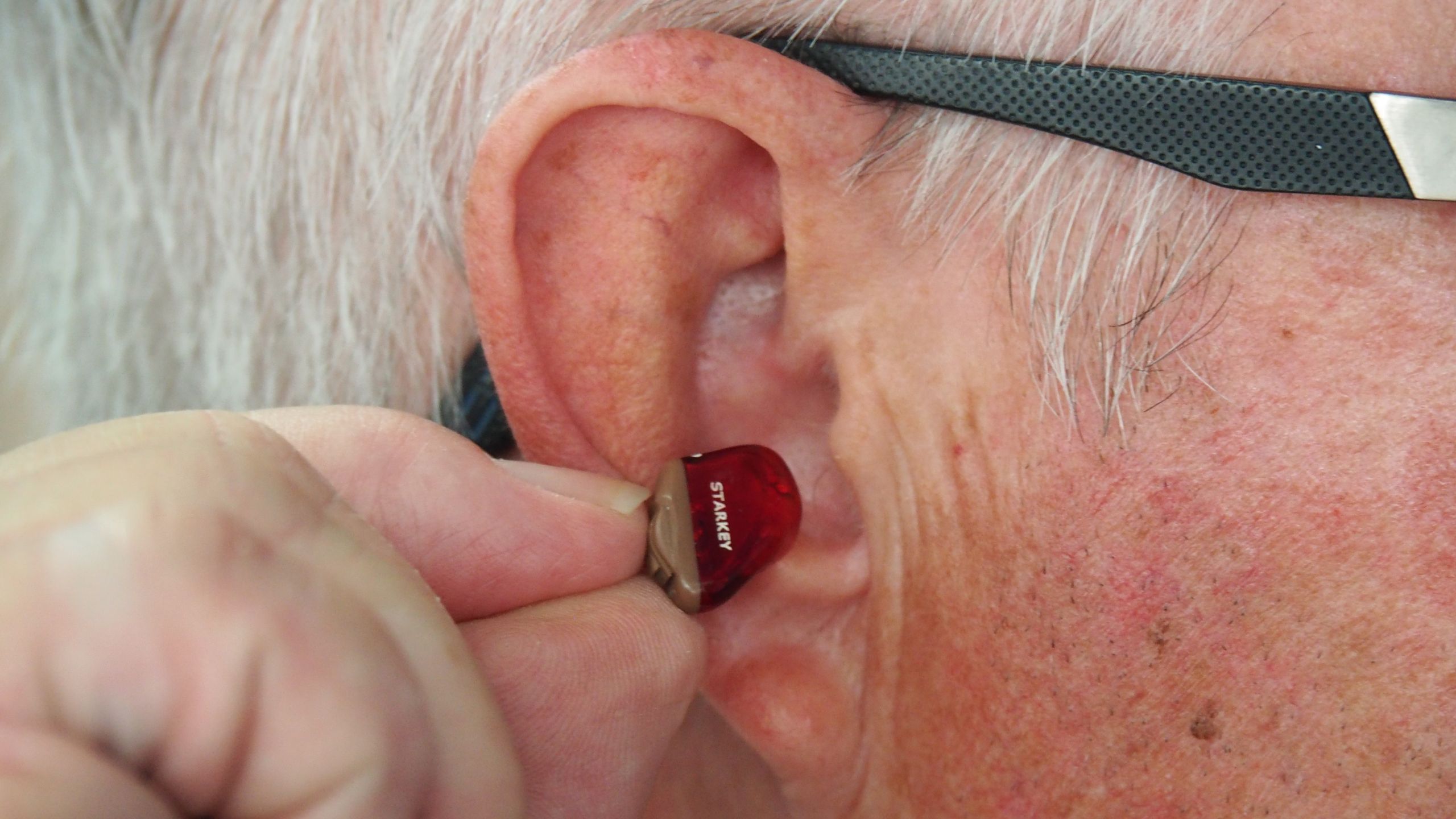
In-the-canal (ITC) hearing aids are slightly larger than CIC models. Since they provide space for controls, you won’t have to reach for an app or remote control every time you need to adjust the volume or program. Models without a vent can occlude the ears, meaning your own voice or chewing might sound louder.
| Pros | Cons |
|---|---|
Less visible than larger models | Requires a custom mold |
Comfortable custom fit | Can cause occlusion |
Outer ear contributes to more natural sound | Limited features |
Normal phone or headgear use | Short battery life |
Rechargeable options available | Challenging to handle and clean |
In-the-ear

In-the-ear (ITE) is a custom type of hearing aid that fills the entire concha or bowl of your ear. These feature more processing and amplification power than the smaller models, making them a good choice for people with more severe hearing loss. They’re also suitable for people with limited dexterity.
| Pros | Cons |
|---|---|
Snug custom fit | Custom mold needed |
Easier to handle and clean than smaller types | Less discreet |
More powerful than smaller models | Lower battery life |
Don't affect phone or headgear use | Can occlude ears |
Rechargeable options available |
Behind-the-ear
The Behind-the-ear (BTE) model is much larger than hearing aids that sit directly in the ear, yet it’s less visible than the larger ITE or ITC types. A clear plastic tube directs amplified sound into the ear, where it typically connects to a custom earmold that sits in the ear canal.
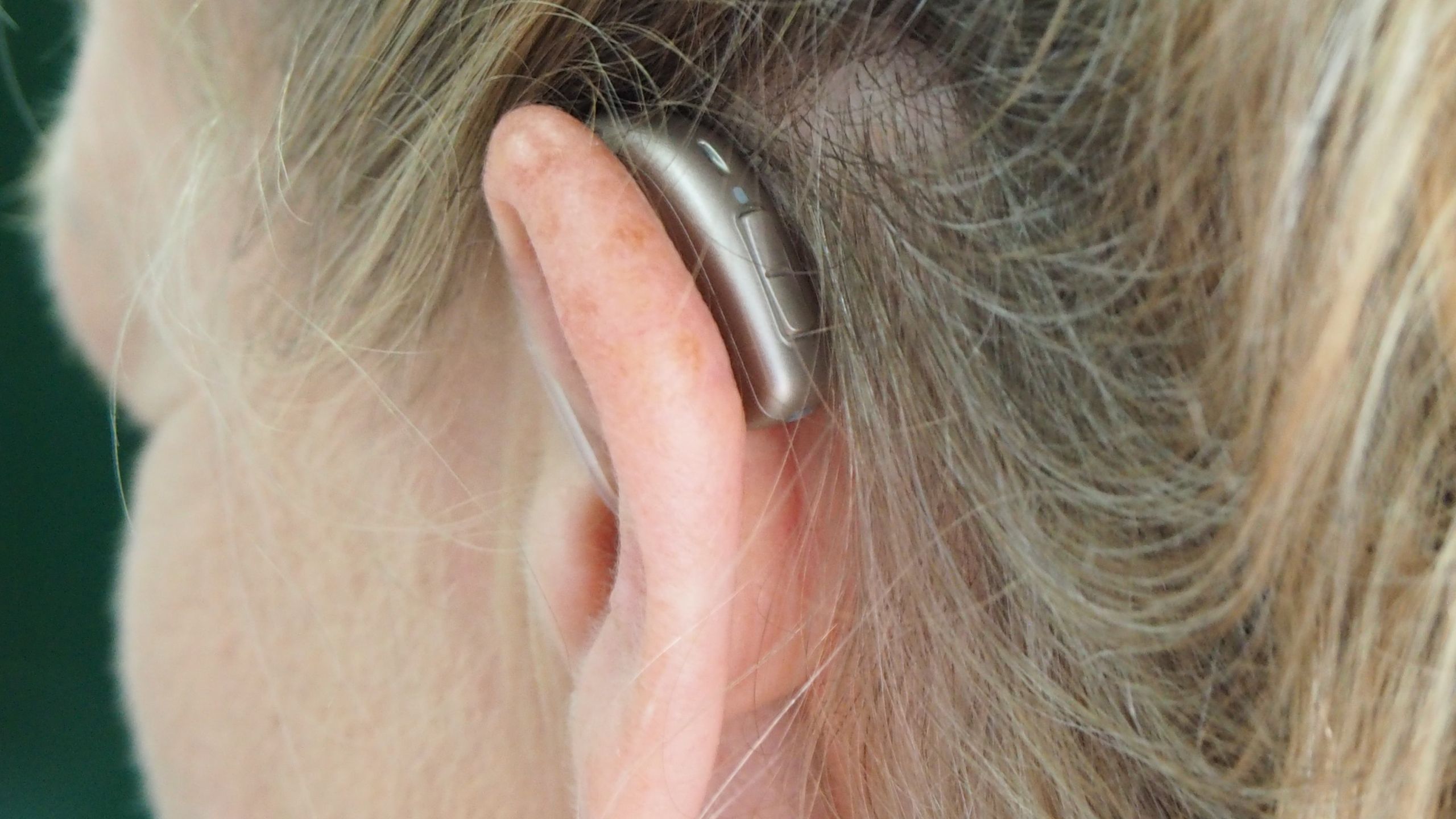
Because its size allows it to pack more battery power and technology, the BTE model provides advanced processing and amplification. While this makes this type most suited for moderate to severe hearing loss, BTE-style hearing aids can also be a good choice for people with mild to moderate hearing loss because you can choose inserts that don’t block the ear canal.
| Pros | Cons |
|---|---|
Long battery life | Lower sound quality |
Rechargeable options available | Visibility |
Easiest handling and maintenance | Can interfere with glasses or a mask |
More affordable | |
Powerful features | |
Unobstructed ear | |
Audio streaming |
Receiver-in-the-canal
Receiver-in-the-canal (RIC) or receiver-in-the-ear (RITE) hearing aids are similar to BTE, except for the positioning of the receiver. This allows this model to be smaller, with no loss in power or features. These are the best choice for people who can’t hear high-pitched sounds.
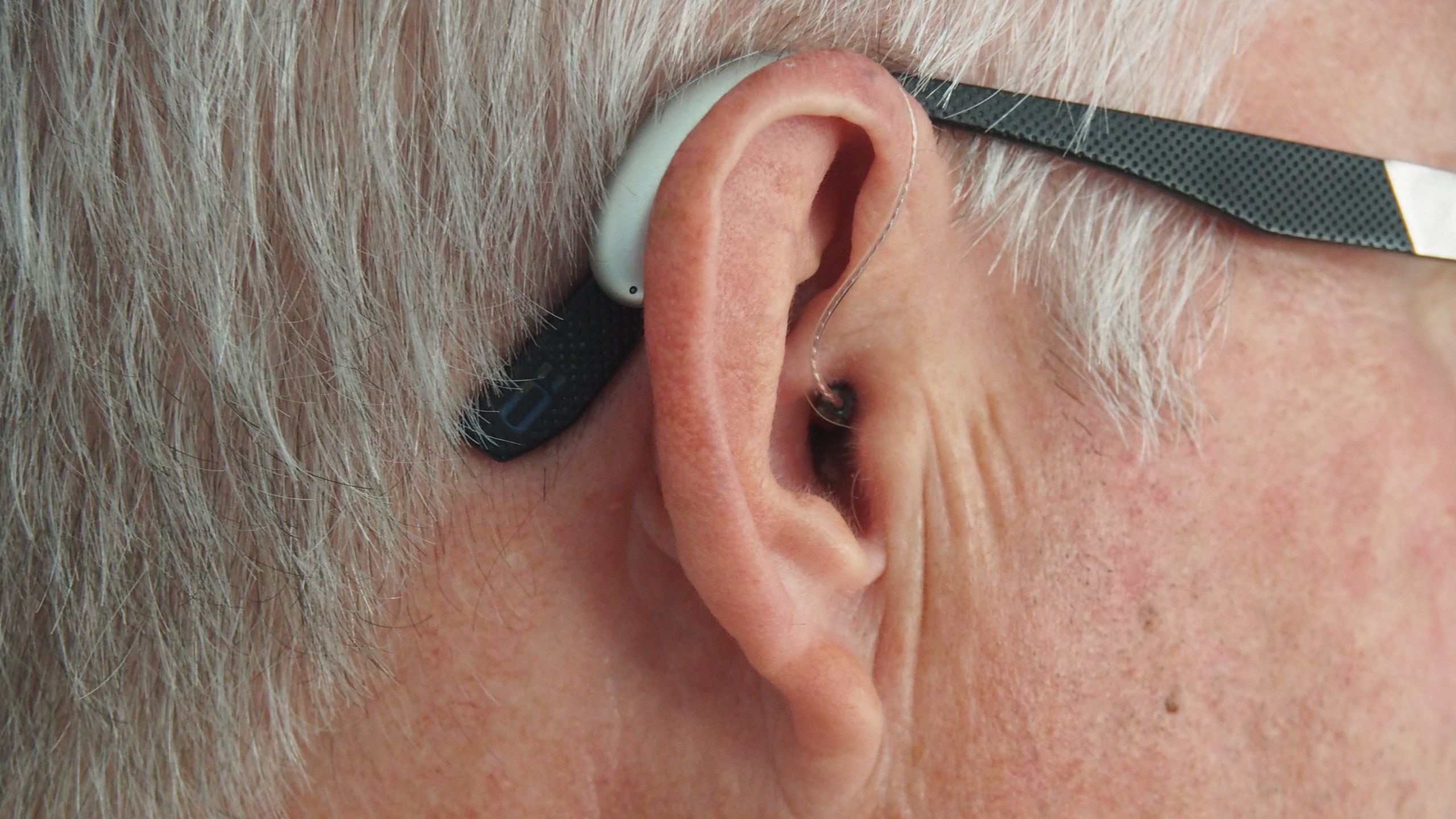
When you choose a RIC hearing aid, you’ll also have to pick disposable ear tips or domes. The soft silicone tip covers the receiver, anchoring it in the ear canal and protecting it from earwax. You can choose between closed domes, open domes, power domes, and tulip domes and each type comes in a range of sizes. People with mild to moderate hearing loss benefit from hearing external sounds and should choose an open dome ear tip. Your audiologist can help you find the perfect type and size for your ears.
| Pros | Cons |
|---|---|
Better sound with less feedback | More visible than smallest models |
Long battery life | Fiddly receiver |
Rechargeable options available | Requires more maintenance |
Powerful features | Receiver prone to damage |
Ear not entirely blocked | Can interfere with wearing glasses or a mask |
Bluetooth streaming | Price |
Earbud
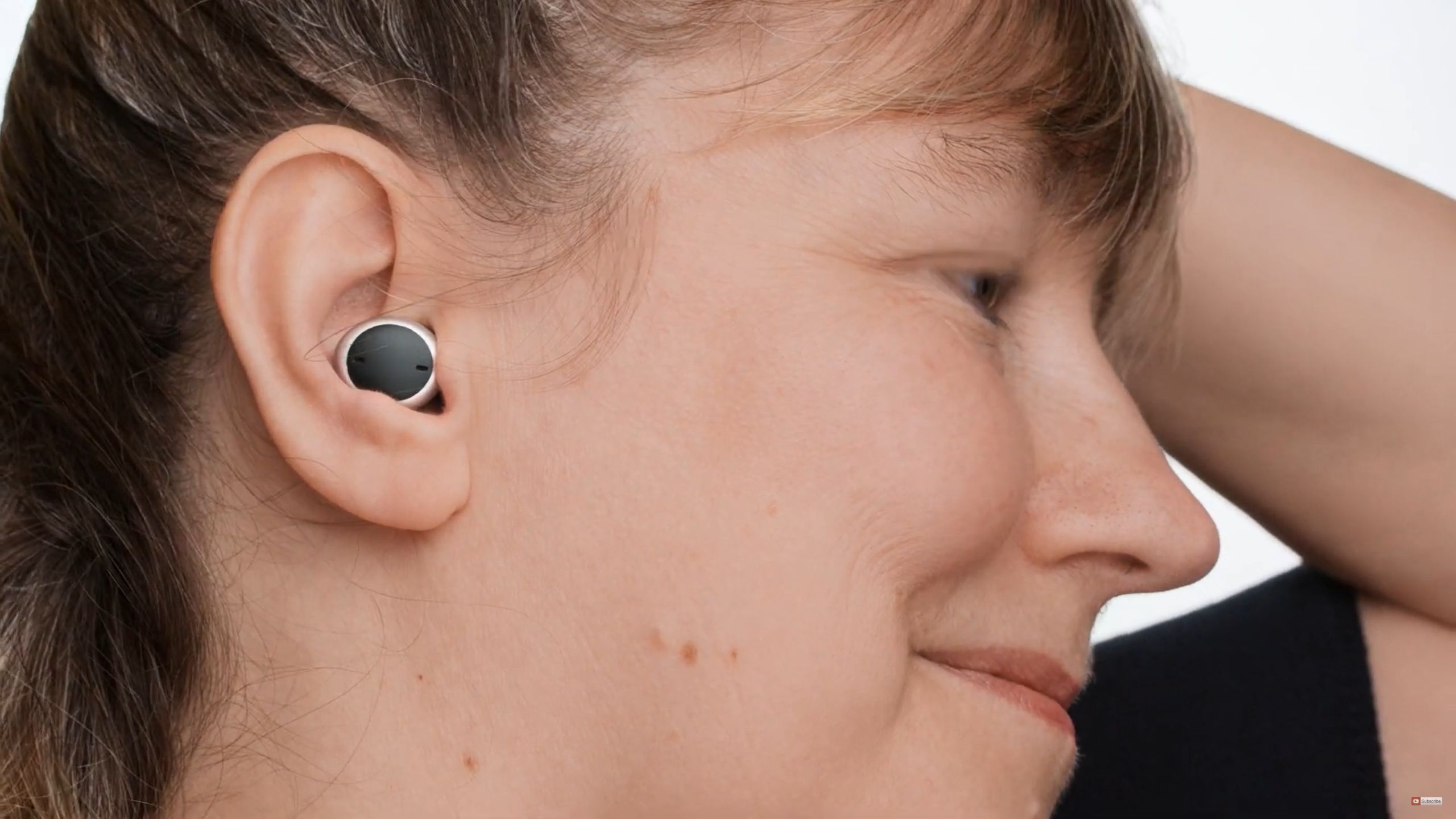
Earbuds are a hybrid between true wireless earphones and hearing aids—quite visible, yet rather discreet. Strictly speaking, many representatives of this model aren’t true hearing aids because, rather than seeing a professional, you’ll fine-tune them yourself using a simplified hearing test.
While they might lack the advanced technology found in classic hearing aids, models from hearing aid-first companies like Signia, do feature real hearing aid technology. Earbud-style hearing aids are best suited for active people with mild to moderate hearing loss who frequently stream audio.
| Pros | Cons |
|---|---|
Stylish design | Not necessarily true hearing aids |
Don't look like hearing aids | Lower sound quality |
Easy to handle | |
Rechargeable | |
Streaming audio |
What features can hearing aids have?
When you’re in the market for a hearing aid, the style is only one thing to consider. For example, if you have hearing loss and a ringing in your ears, look into hearing aids that offer a tinnitus feature. Here are key features you should consider:
| Feature | Description | Who should get it |
|---|---|---|
| Feature Artificial intelligence (AI) | Description Machine learning and neural networks are AI features that help hearing aids learn how to interpret sound and process it in beneficial ways. Many digital hearing aids contain modern processors that can tap into this technology and automatically adapt sound processing and amplification to environmental sounds. | Who should get it Anyone who can. |
| Feature Noise reduction | Description Programmed noise reduction to remove feedback, sound artifacts, such as wind noise, and enhance speech over background sounds. It's potentially a step down from AI because it can't automatically adapt to changing environmental sounds, nor can it integrate new data. | Who should get it Anyone who can't get AI features. |
| Feature Directional microphone | Description This is in addition to an omnidirectional microphone. While the omnidirectional microphone picks up sounds from all directions, the directional microphone picks up sounds from a specific direction, usually from in front of the wearer. Adaptive directional microphones can amplify the sound they capture, while removing background noise. | Who should get it People who want to use their hearing aids in noisy social settings where it's hard to focus on speech. |
| Feature Rechargeable battery | Description Most hearing aids come with replaceable coin cell batteries. Many newer models offer rechargeable options, meaning you don't have to replace the battery every few months. The downside is that these hearing aids might require daily recharging and the lifespan of lithium-ion batteries is limited, though should last 4-5 years in hearing aids. | Who should get it People who have issues with dexterity and don't want to replace small batteries. |
| Feature Bluetooth/wireless connectivity | Description Other than connecting your hearing aids to your phone and controlling them through the app, the main purpose of wireless connectivity is audio streaming. If you have an iPhone, check the hearing aid for the MFi (Made for iPhone) logo. If you're an Android user, check for ASHA (Android Streaming for Hearing Aid) support. These protocols will let you stream audio directly to your hearing aids, meaning you can use them like headphones. | Who should get it Anyone keen to stream audio from Bluetooth devices directly to their hearing aids. If you're frequently chatting or taking phone calls on your phone, this is a must-have feature. |
| Feature Telecoil | Description Hearing aids with a telecoil can pick up signals from a loop system and stream the sound directly into your ear. Originally, this feature was designed for telephones. Today, you'll find telecoil systems in many public places in the U.S., including federal buildings, opera houses, cinemas, and cabs. Look for the blue sign with an ear in the center and a capital T in the lower right corner. Most hearing aids can contain this feature, but CIC style aids are too small to fit a t-coil. | Who should get it People who value high quality audio streams in public venues that support telecoil. |
| Feature Mobile app | Description All digital hearing aids come with an Android or iOS app. The app lets you control settings and may also help you connect with your care provider. | Who should get it Anyone who doesn't mind controlling their hearing aids using a mobile app and appreciates managing additional settings and features. |
| Feature Remote control | Description Some hearing aids feature a remote control as an alternative to an app or controls on the hearing aid itself. | Who should get it People who don't want to use a mobile app to control their hearing aids. |
| Feature Coded high-frequency sound control | Description This is a way to control the hearing aids from the mobile app without Bluetooth. It's not recommended if you have pets or young kids as the coded sound is audible to individuals with great hearing. | Who should get it It's a nice-to-have feature, but largely unnecessary. Get it if you don't want to use your phone's Bluetooth connection. |
| Feature Tinnitus features | Description An optional hearing aid program that targets the wearer's tinnitus with white noise or custom sounds that distracts from the tinnitus and may reduce it over time. Tinnitus programs include tinnitus retraining therapy, tinnitus masking, or sound therapy. | Who should get it Anyone who suffers from tinnitus and struggles to focus, relax, or fall asleep due to the constant ringing in the ears. |
Note: the smaller the hearing aid, the more limited its features.
When should you get a hearing aid?
Hearing aids can do a lot more than restore your hearing. In the long run, hearing loss may affect your emotional and physical well-being. Improved hearing can protect you from a host of psychiatric disorders, including cognitive impairment, depression, anxiety, and more. Getting a hearing aid is definitely worth the hassle, but not so fast!

An age-related decline affecting one’s ability to hear high-frequency sounds is normal. What’s concerning is a rapid decline at a young age or significant levels of hearing loss, especially if it affects speech recognition. The cause of hearing loss can be noise-induced hearing loss or an organic reason and for adequate treatment, you should find out what it is. Hearing aids can help with mediating sensorineural hearing loss, but you might need a different treatment if you have a different type of hearing loss.
If you suspect you have hearing loss, be sure to get a diagnosis first. An ear, nose, and throat (ENT) doctor can examine your ears, refer you to an audiologist for a full audiogram, and order further tests if needed. The audiogram measures the quality of your hearing and will reveal whether you can benefit from a hearing aid. The audiologist or your doctor will likely recommend a hearing aid if you have asymmetric hearing loss or if you struggle to understand speech. If you do need a hearing aid, you should also obtain an audiogram to get a perfect hearing aid fit.
How to choose a hearing aid
Now that you have an overview of all your options, you may be wondering how you’re supposed to pick the right hearing aid for you. And we haven’t even touched on the various brands and models, yet. There’s also another complicating factor, which is where to buy your hearing aid.
Where to look for a hearing aid
You may have seen hearing aids for sale online or over-the-counter (OTC) at a local store. Even audio companies like Sony, Bose, and Jabra have released OTC hearing aids. On the surface, these may look like are more affordable options than going through a hearing clinic.
If this is your first time looking into hearing aids, however, we strongly recommend getting a professional checkup and an audiogram before you choose an online or OTC hearing aid. An audiologist will have a few different types of hearing aids available for you to try out. You may even be able to take them home for a trial period. Based on your hearing profile and personal preferences, the audiologist can help you pick the hearing aid that best addresses your hearing loss.
What to look for in a hearing aid
Whether you go with a hearing clinic, a Costco Hearing Aid Center, or another hearing devices provider, keep the following in mind:
- Try out different styles of hearing aids and different brands to see which ones you can handle more easily.
- For mild or moderate hearing loss, try out CIC, ITC, or RIC models.
- For more severe hearing loss, opt for ITC, ITE, or BTE with earmold and an assistive listening device.
- When you’re trying on RIC or RITE type hearing aids, be sure to also try on different styles and sizes of ear tips to find the perfect fit.
- Try wearing your hearing aid with glasses or a mask.
- If you struggle with dexterity, i.e. handling small objects, choose a larger model with fewer parts, like ITE or BTE with an earmold, automated features, and rechargeable batteries.
- If you’re handicapped or home-bound, a BTE model with earmold, basic features, and an assistive listening device might be a safe choice.
- Should you also have ringing in your ears, inquire about tinnitus solutions.
- Once you’ve narrowed down the selection to a few specific models, try out the mobile apps for those hearing aids to see which one you like best.
- Ask your provider about warranty and maintenance conditions and whether you’ll get a replacement when repairs take longer.
- Finally, choose a model that’s repairable and allows for future upgrades. While you should prevent further hearing loss, that’s not always possible.
How to get used to your new hearing aid
It’ll take time to get used to your hearing aids. To get familiar with them and build a habit, wear them as often as you can, and try out every feature during the trial period. If the hearing aids don’t work as expected, get in touch with your audiologist.
Here are some common problems with hearing aids:
- The hearing aid feels uncomfortable: This may be a matter of time, especially if you’re using a custom earmold. If you’re using a RIC type hearing aid, experiment with different types or ear tips and sizes.
- Your own voice is too loud: Occlusion is a common side effect of hearing aids that plug up your ear canal, such as CIC, ITC, or any models with an earmold. This is something you can get used to, but some hearing aids have advanced features that eliminate this effect. Ask your audiologist about your options.
- You experience feedback or sound artifacts: This could be a sign of a poorly fitting or clogged up hearing aid. Be sure to clean your hearing aid as per the manufacturer’s instructions. If the feedback persists, contact your audiologist.
- Background noise is too loud: The program you’re using might need adjustments. If you went with a less advanced hearing aid, you might not be able to get a better result. Try out models with AI and dual processors.
- Your hearing aid is too quiet: If you can’t adjust the volume yourself, consult with your audiologist. This should be an easy fix for them.
Most issues are a matter of getting used to handling and wearing your new hearing aids, but some require professional intervention. Hearing aids are a major investment, and they should last you many years, so be sure to rigorously test them during the trial or warranty period. Once you have hearing aids, take good care of them and periodically test your hearing to make sure your aids still work as they should.
Thank you for being part of our community. Read our Comment Policy before posting.